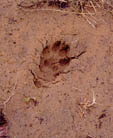 Saturday, April 21
Saturday, April 21Saturday was the first day of the week-long Blogger Bioblitz event. Hot day--fierce sun, and I got a late start, so I thought I'd just do a reconnaisance of a location in the cedar bush, where the stream runs through, that I thought might be interesting. I'd hoped to list flora, but was frustrated in that the only recognizable flora were ones I already knew were there, i.e., exactly where. Nothing else was far enough along to identify (or in most cases to find). There is a common fern back there that's just coming up now--but I don't know its name, and there wasn't enough of it to work on. That was one of a series of very warm days, followed by some rain, and more to come (maybe) over the next few days (along with cooler temperatures, though not real cold)--so I'll go back there again next Saturday when more might be up and recognizable. As it was I listed a few of the plants that were up and about, a frog, and birds:
Weather: hot and sunny
Temperature was 20C when I left the house around 9:00 am, and up to 23C an hour later.
Flora-
white cedar (
Thuja occidentalis
-
white birch (
Betula papyrifera) This birch was in the middle of the cedars--the only one there, which led me to speculate that it is older than they are. bot are relatively fast-growing trees, and I don't think the birch would be able to get going in the shade of the cedars. There are a number of dead birches and poplars in the wetter parts of the area.
-
marsh marigold (
Caltha palustris) Well leafed out, no sign yet of the blossoms.
Frogs-
spring peeper (
Pseudacris crucifer) One calling (not really their time of day).
BirdsI just counted birds I heard or saw that belonged to the habitat--the area of bush and swamp is small, and I could also hear birds singing in the field beyond.
-
Ruffed Grouse (
Bonasa umbellus)
-American Crow (
Corvus brachyrhynchos)
-Black-capped Chickadee (
Poecile atricapillus)
-American Robin (
Turdus migratorius)
-Northern Cardinal (
Cardinalis cardinalis)
-Red-winged Blackbird (
Agelaius phoeniceus)
-American Goldfinch (
Carduelis tristis) Okay, the goldfinches don't really belong here--but at this time of the year they are hanging around in large, noisy flocks, insisting on being recorded.
Mammals-red squirrel (
Tamiasciurus hudsonicus)
Walking back through the fields I saw my first Tree Swallows of the year. And later in the day I saw my first Barn Swallows. Finally second (or maybe third) wave migration is well underway.
Monday, April 23Monday I got out early, around 6:30 am, to avoid full sun and to look closely at the edge of the far field. This time I ignored the flora--I am hoping now to have a flora day at the end of the week. I don't know if I'll count the sumach, prickly ash, red cedar, etc., but I'll get up some kind of list.
So, I set out, again, at a dawdle, back through the fields. I saw
Grizzly Man over the weekend, so I had bears on the brain--but the only bear sign I saw was from last summer (turned-over rocks). No vibe of large animals, lots of fox and coyote tracks, as ever, but nothing conspicuosly fresh.
Mammals
What was fresh was a set of racoon tracks (Procyon lotor).
Who was out there with me? An eastern cottontail (Sylvilagus floridanus)--way at the northwest corner of the far field. (I'm not counting the cottontails I have to push aside to get out of the yard.)
Birds
Because of the time of day, and the temperature, around 15C (i.e., not 2C), there was lots of bird activity. I should do a list in order, but I think I'll stick to narrative.
A flock of 100 Canada Geese, heading north, flew overhead, followed moments later by another of about 50. Robins were singing in every corner of the field. A single cardinal was as well--moving all around a couple of acres. I saw two field sparrows, and listened to another two, my first clear hearings of the year. Chickadees followed me along the edge. The noisy flock of goldfinches made lots of noise. A flicker called.  A ruffed grouse drummed (and I flushed a another out of the edge of the cedar bush as I went by). Song sparrows were everywhere.
A ruffed grouse drummed (and I flushed a another out of the edge of the cedar bush as I went by). Song sparrows were everywhere.
Someone must be nesting now--I know that chickadees may be, and the song sparrows and blue jays show signs that they are too. But I figure cowbirds know. I saw a courting group (first three then six or seven males following a female, strutting and posing) moving around the treetops at the field's edge. but best of all, a pair of Belted Kingfishers. Sometimes these birds nest well away from the water where they feed, at the end of long tunnels they excavate into banks of earth. I don't know that they've nested back there--but I've seen them scouting there before. It was a pleasure to see and hear them there again.
I'd hoped that there might be warblers, and there is a chance for one or two by the end of the week (last year my first was a black and white), but it really is just a little too early. Just yesterday I saw my first chipping and white-throated sparrows.








